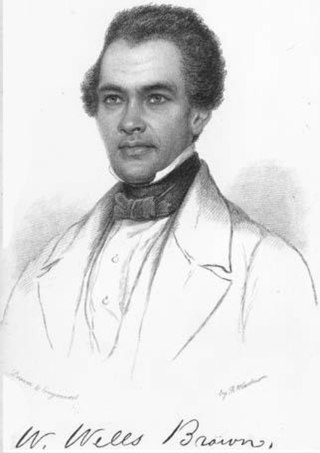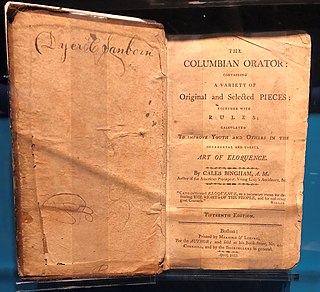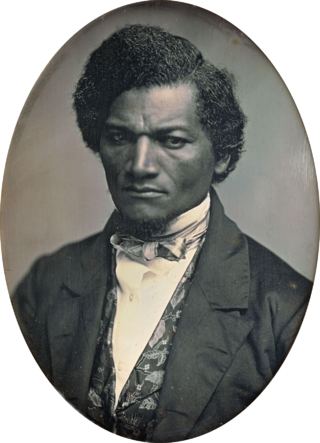
Frederick Douglass was an American social reformer, abolitionist, orator, writer, and statesman. He became the most important leader of the movement for African-American civil rights in the 19th century.
The slave narrative is a type of literary genre involving the (written) autobiographical accounts of enslaved Africans, particularly in the Americas. Over six thousand such narratives are estimated to exist; about 150 narratives were published as separate books or pamphlets. In the United States during the Great Depression (1930s), more than 2,300 additional oral histories on life during slavery were collected by writers sponsored and published by the Works Progress Administration, a New Deal program. Most of the 26 audio-recorded interviews are held by the Library of Congress.

Abolitionism, or the abolitionist movement, is the movement to end slavery and liberate enslaved people around the world.

Harriet Jacobs was an African-American abolitionist and writer whose autobiography, Incidents in the Life of a Slave Girl, published in 1861 under the pseudonym Linda Brent, is now considered an "American classic".

Henry Box Brown was a 19th-century Virginia slave who escaped to freedom at the age of 33 by arranging to have himself mailed in a wooden crate in 1849 to abolitionists in Philadelphia, Pennsylvania.

Incidents in the Life of a Slave Girl, written by herself is an autobiography by Harriet Jacobs, a mother and fugitive slave, published in 1861 by L. Maria Child, who edited the book for its author. Jacobs used the pseudonym Linda Brent. The book documents Jacobs's life as a slave and how she gained freedom for herself and for her children. Jacobs contributed to the genre of slave narrative by using the techniques of sentimental novels "to address race and gender issues." She explores the struggles and sexual abuse that female slaves faced as well as their efforts to practice motherhood and protect their children when their children might be sold away.

William Wells Brown was an American abolitionist, novelist, playwright, and historian. Born into slavery near Mount Sterling, Kentucky, Brown escaped to Ohio in 1834 at the age of 19. He settled in Boston, Massachusetts, where he worked for abolitionist causes and became a prolific writer. While working for abolition, Brown also supported causes including: temperance, women's suffrage, pacifism, prison reform, and an anti-tobacco movement. His novel Clotel (1853), considered the first novel written by an African American, was published in London, England, where he resided at the time; it was later published in the United States.

The Columbian Orator is a collection of political essays, poems, and dialogues collected and written by Caleb Bingham. Published in 1797, it includes speeches by George Washington, Benjamin Franklin, and some imagined speeches by historical figures such as Socrates and Cato. It was popularly used for recitation in American schoolrooms from 1790 to 1820 to teach pupils reading and speaking. Typical of many readers of that period, the anthology celebrated "republican virtues," promoting patriotism and questioning the ethics of slavery. The Columbian Orator is an example of progymnasmata, containing examples for students to copy and imitate.

Rev. Jermain Wesley Loguen, born Jarm Logue, in slavery, was an African-American abolitionist and bishop of the African Methodist Episcopal Zion Church, and an author of a slave narrative.

David Ruggles was an African-American abolitionist in New York who resisted slavery by his participation in a Committee of Vigilance and the Underground Railroad to help fugitive slaves reach free states. He was a printer in New York City during the 1830s, who also wrote numerous articles, and "was the prototype for black activist journalists of his time." He claimed to have led more than 600 fugitive slaves to freedom in the North, including Frederick Douglass, who became a friend and fellow activist. Ruggles opened the first African-American bookstore in 1834.

During the era of slavery in the United States, the education of enslaved African Americans, except for religious instruction, was discouraged, and eventually made illegal in most of the Southern states. After 1831, the prohibition was extended in some states to free blacks as well. Even if educating Blacks was legal, they still had little access to education, in the North as well as the South.

The Heroic Slave, a Heartwarming Narrative of the Adventures of Madison Washington, in Pursuit of Liberty is a short piece of fiction, or novella, written by abolitionist Frederick Douglass, at the time a fugitive slave based in Boston. When the Rochester Ladies' Anti Slavery Society asked Douglass for a short story to go in their collection, Autographs for Freedom, Douglass responded with The Heroic Slave. The novella, published in 1852 by John P. Jewett and Company, was Douglass's first and only published work of fiction.

Life and Times of Frederick Douglass is Frederick Douglass's third autobiography, published in 1881, revised in 1892. Because of the emancipation of American slaves during and following the American Civil War, Douglass gave more details about his life as a slave and his escape from slavery in this volume than he could in his two previous autobiographies. It is the only one of Douglass's autobiographies to discuss his life during and after the Civil War, including his encounters with American presidents such as Lincoln and Garfield, his account of the ill-fated "Freedman's Bank", and his service as the United States Marshall of the District of Columbia. Frederick Douglass shed light on what life was like as an enslaved person. Although it is the least studied and analyzed, Life and Times of Frederick Douglass allows readers to view his life as a whole.
William Parker was an American former slave who escaped from Maryland to Pennsylvania, where he became an abolitionist and anti-slavery activist in Christiana. He was a farmer and led a black self-defense organization. He was notable as a principal figure in the Christiana incident, 1851, also known as the Christiana Resistance. Edward Gorsuch, a Maryland slaveowner who owned four slaves who had fled over the state border to Parker's farm, was killed and other white men in the party to capture the fugitives were wounded. The events brought national attention to the challenges of enforcing the Fugitive Slave Law of 1850.

Anti-literacy laws in many slave states before and during the American Civil War affected slaves, freedmen, and in some cases all people of color. Some laws arose from concerns that literate slaves could forge the documents required to escape to a free state. According to William M. Banks, "Many slaves who learned to write did indeed achieve freedom by this method. The wanted posters for runaways often mentioned whether the escapee could write." Anti-literacy laws also arose from fears of slave insurrection, particularly around the time of abolitionist David Walker's 1829 publication of Appeal to the Colored Citizens of the World, which openly advocated rebellion, and Nat Turner's slave rebellion of 1831.

The treatment of slaves in the United States often included sexual abuse and rape, the denial of education, and punishments like whippings. Families were often split up by the sale of one or more members, usually never to see or hear of each other again.

William Lawrence Chaplin was a prominent abolitionist in the years before the American Civil War. Known by the title of "General," he was an agent for the American Anti-Slavery Society and a general agent for the Underground Railroad. He was imprisoned for the attempted escape of two individuals, which required $25,000 to get out of jail and safely out of Maryland. He was an editor at two anti-slavery newspapers and he was a Harvard-educated lawyer for a couple of years. He and his wife operated the Glen Haven Water Cure spa in his later years.

"What to the Slave Is the Fourth of July?" was a speech delivered by Frederick Douglass on July 5, 1852, at Corinthian Hall in Rochester, New York, at a meeting organized by the Rochester Ladies' Anti-Slavery Society. In the address, Douglass states that positive statements about perceived American values, such as liberty, citizenship, and freedom, were an offense to the enslaved population of the United States because they lacked those rights. Douglass referred not only to the captivity of enslaved people, but to the merciless exploitation and the cruelty and torture that slaves were subjected to in the United States.

Abolitionism in New Bedford, Massachusetts, began with the opposition to slavery voiced by Quakers during the late 1820s, followed by African Americans forming the antislavery group New Bedford Union Society in 1833, and an integrated group of abolitionists forming the New Bedford Anti-Slavery Society a year later. During the era New Bedford, Massachusetts, gained a reputation as a safe haven for fugitive slaves seeking freedom. Located on the East Coast of the United States, the town was becoming the "whaling capital of the world", where ships frequently returned to port, operated by crews of diverse backgrounds, languages, and ethnicity. This made it easy for fugitive slaves to "mix in" with crew members. The whaling and shipping industries were also uniquely open to people of color.
Abolitionist children’s literature includes works written for children by authors committed to the movement to end slavery. It aimed to instill in young readers an understanding of slavery, racial hierarchies, sympathy for the enslaved, and a desire for emancipation. A variety of literary forms were used by abolitionist children’s authors including, short stories, poems, songs, nursery rhymes and dialogues, much of it written by white women. Pamphlets, picture books and periodicals were the primary forms of abolitionist children’s literature, often using Biblical themes to reinforce the wickedness of slavery. Abolitionist children's literature was countered with pro-slavery material aimed at children, which attempting to depict slavery as a noble pursuit, and slaves as stupid and grateful, or evil.




















